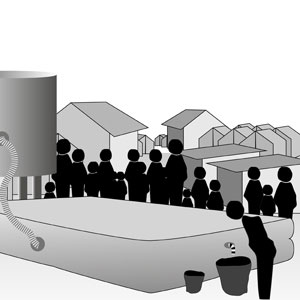When dealing with large groups of people, water emergencies might require small-scale centralised water treatment and supply systems to provide appropriate quantities of drinking water. These options can provide communities, camps or a group of households with up to 100m3 drinking water per day. Although expensive, these (mainly) modular units prove to be useful in the immediate stages of an emergency and when displaced populations are considered to stay at the same place for several weeks. They are also suitable to treat industrially polluted water or to supply specific units e.g. health centres. Newer technologies (e.g. membrane or reverse osmosis water purification) are subject to research and further development at present.
| المُدخلات | المُخرَجات |
|---|---|
Drinking Water |
Water and sanitation (see also water supply and purification in emergencies and sanitation in emergencies (see PPT)) are critical constituents for survival immediately after and during the initial stages of a disaster (GWC 2009). Therefore, the availability of sufficient water of the highest achievable standard in the immediate aftermath of a disaster is a crucial factor to take care of the sick, provide for human consumption, safeguard basic hygiene, support search & rescue efforts and ensure that both the productive and commercial activities get back to normal as fast as possible.
Where larger groups of people are displaced, either by conflict or by natural disaster and they are likely to stay in a particular location for periods in excess of a few weeks, there will be a need to establish and probably subsequently upgrade a centralised water treatment and supply system (OXFAM 2001). There are many types of water treatment and purification systems available, however, the methods are not too differing. The choice of the most adequate system depends on the number of people to be delivered with treated water.
In general, untreated water is abstracted from a surface water source or directly from an existing distribution system and accumulated in a storage reservoir. The initial treatment process consists of filtration or sedimentation to remove particulate matter from the untreated water. Then, a disinfection process is conducted (usually chlorination) to kill any remaining bacterial and viral pathogens from the filtrated water. Under some conditions in the field, untreated water might require other treatments steps to reduce odour, high bacteria counts, etc. (HOLLAND & GARLAND 1989; HOUSE & REED 1997; UNHCR 2008).
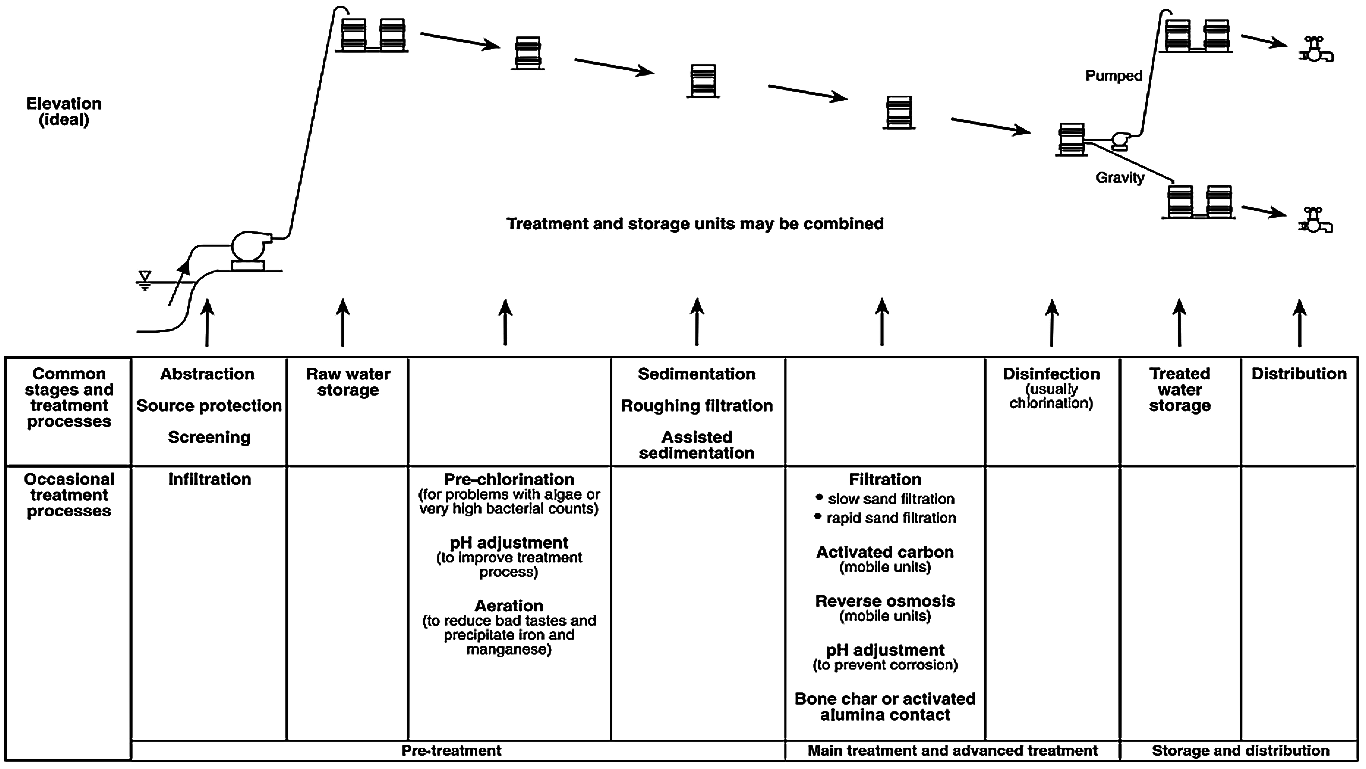
The difficult circumstances in emergencies often pose an assortment of challenges to Emergency Water Treatment Equipment (E.W.T.E.) (HOLLAND & GARLAND 1989):
- Where the units are used to treat water with high turbidity, high algae content, high iron content, high salinity, or containing oil residuals;
- Where the units are located at water sources remote from a convenient point of distribution;
- Where size and weight of the module components (of the E.W.T.E. unit) limit transportation of equipment;
- And where the E.W.T.E. units are not equipped with sufficient additional apparatus to allow operators to adapt to local constraints.
In emergency situations, Mobile Water Treatment Equipment (M.W.T.E) (pre-assembled) and modular water treatment kits (to be assembled in the field) are used to produce drinking water. Treatment systems differ in terms of the type of the raw water (i.e. fresh or salt water and ground- or surface water), the underlying process (i.e. mechanical, physical or chemical) and the mechanism of delivery (pre-assembled or to be assembled in the field). Most larger relief organisations, governmental relief agencies or respective military divisions, have their own selection of modular kits and mobile units (HOUSE & REED 1997).
Different procedures of water treatment:
- Filtration of fresh water by pre-assembled mobile water treatment units water (e.g. PWN Technologies or Katadyn filters)
- Filtration of salt or brackish water by mobile water treatment units
- Coagulation-flocculation and disinfection of fresh water by modular water treatment kits.
Today, many manufacturers offer water treatment units and water kits on the global market and technology development enables on-going improvement of the apparatus. The products presented here are randomly chosen to explain technology. Technical data provided by the manufacturer has not been verified.
M.W.T.E’s (pre-assembled), mounted on trailers or in shipping containers, usually combine coagulation, filtration and disinfection, or simply filtration and disinfection. These units can provide 4'000 to 50'000 litres/hour. They can rapidly produce water of high quality without the need to design and construct semi-permanent water treatment facilities. However, they are expensive to have on-hand for emergency use, and they require a water source near the affected area, as well as specialist technical expertise for operation and maintenance. Individual trainings for operators in the field are required and often different system fittings (e.g. for pipes) are not system compatible (WISNER & ADAMS 2002; HOUSE & REED 1997).
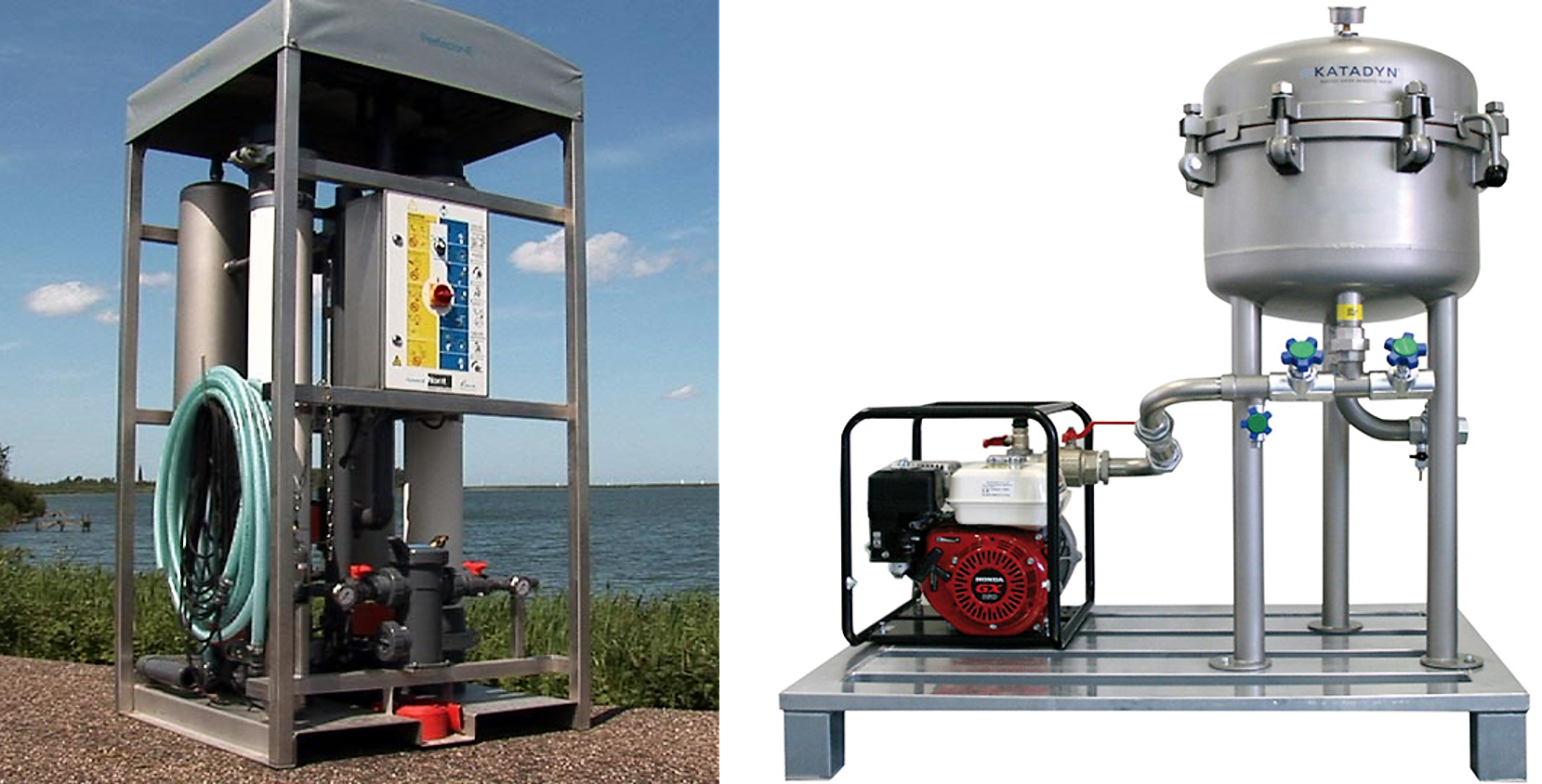
Adapted from: WHO (2008)
To generate drinking water from salt or brackish water, membrane processes such as reverse osmosis, ultra filtration, micro filtration and nano filtration are used. These processes have traditionally been applied to the production of water for industrial or pharmaceutical applications but are now more and more being implemented for the process of drinking water treatment (e.g. TRUNZ Water systems).
Small-scale desalination units have found application in emergencies in recent years providing drinking water to households or communities. They present specific challenges to continue effective operation through maintenance procedures (one consideration is their high energy requirement). Generally, the number of such desalination units is increasing and it is likely that this development is continuing due to increasing water scarcity. Brackish water from sources such as lake and sea may contain particulates not encountered in freshwater systems such as algal content and chemicals, such as boron and bromide, which is often abundant in seawater. The effectiveness of some of the processes employed in desalination to remove some substances of health concern remains inadequate.
Modular water kits (to be assembled in the field) for use in emergencies are robust, easy to assemble, lightweight, pre-packaged, portable by road or air, and can produce once operational up to 600’000 litres/day (IFRC 2008). They come complete and ready for installation, and are designed for installation on location within hours of arrival by a team of semi-skilled workers with some supervision by an experienced engineer. They can be easily disassembled, moved and reassembled. The kits used by a number of different agencies are compatible thanks to the inclusion of a range of types and sizes of pipe fittings (WISNER & ADAMS 2002; HOUSE & REED 1997). These systems do not treat salt or brackish water.
As an example, the International Federation of Red Cross (IFRC), disposes of different kits and so-called Emergency Response Units (ERU) to respond to water, sanitation and hygiene promotion needs in emergencies. Choice is made based on location of the emergency, number of beneficiaries, types of intervention, water volume and services required. If the response has to supply water to more than 10’000 beneficiaries, IFRC deploys the ERU, which includes supporting professionals (IFRC 2008).
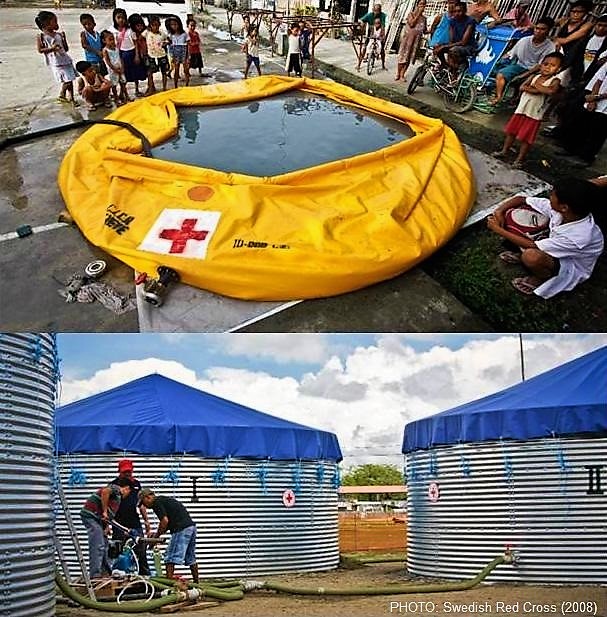
Another similar system is advertised by Scan Water. According to its manufacturer, it produces up to 4’000 litres per hour. Hence, it is suitable for refugee camps, villages, military applications. It has been used by UN agencies, Red Cross Societies and other international agencies throughout Africa, Asia and South America since 2000 (SCAN WATER 2011). The system is characterised by simple operation, effective removal of turbidity and a favourable price–performance ratio (IFRC 2005).
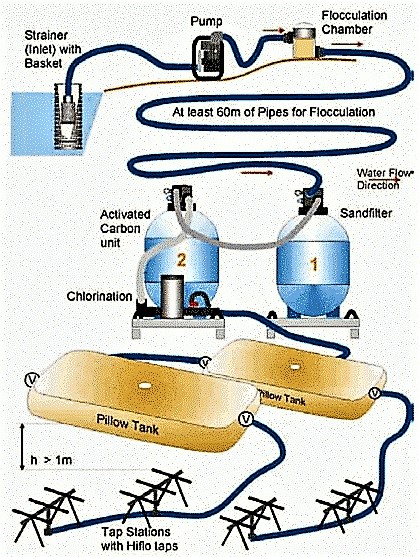
A diesel-driven pump draws water from the water source. The unprocessed water is then pumped through coagulation and flocculation chambers to the sand filter stage via a minimum 60m of pipe network to ensure proper flocculation. Then, the water is pumped through a carbon filter and through an in-line chlorination unit (with an optional liquid feed device). After chlorination, the water is pumped into a number of 10’000 litre pillow tanks. Finally, safe drinking water is supplied from water tap stations (SCAN WATER 2011).
Once the water has been treated by one of the semi-centralised treatment units described above, it has to be distributed. Commonly, water is distributed efficiently within the community or camp using a pipe network. Where possible, the distribution network should incorporate a water storage tank. The tank may be filled slowly over a 24-hour period allowing people to draw suitable water quantities on demand. Residual chlorine is generally added to ensure that no harmful micro organism grow in the water after treatment before it is consumed. Alternatively, distribution conducted by water tankers can be suitable as a short-term measure in case transport means and infrastructure are in an acceptable condition and personnel is available.
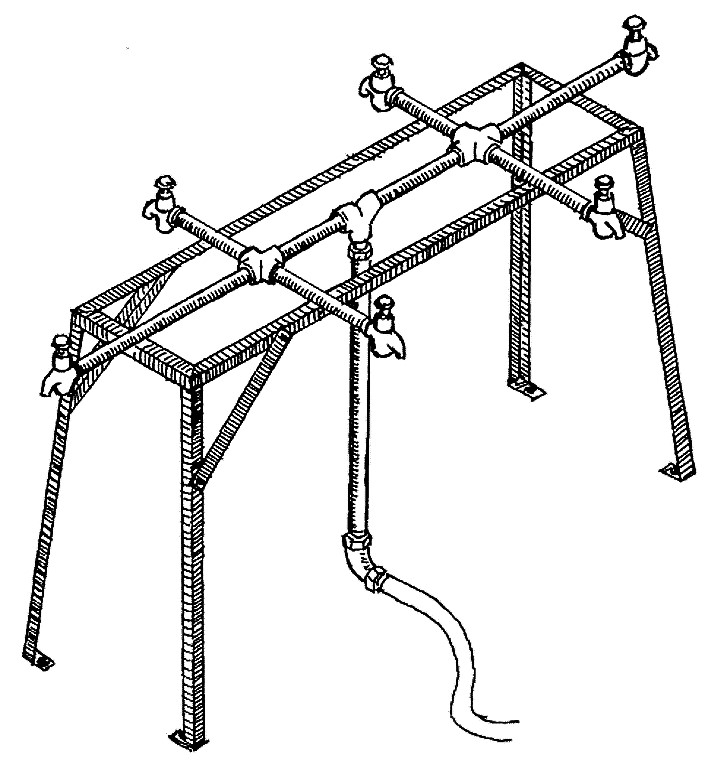
The water-collection point usually comprises a series of taps attached to the end of the pipe network. Tap stands should be evenly distributed throughout the camp, and must be strong enough to withstand frequent and intensive use (REED & SHAW 1999; UNHCR 2007).
In a refugee camp, there should be a tap ratio of 1 tap per 80 to 100 refugees. Apart from adequacy, equity, satisfactoriness and safety of distributed water, the following aspects of managing water distribution should be considered (UNHCR 1992; UNHCR 2007):
- Minimise social costs (burden) on the users: Facilities located centrally and not too distant from the dwellings, reduced waiting time and incorporating user-friendly design.
- Ensure physical safety of the users: Facilities located in a secure physical environment; water distribution time planned according to users’ convenience and cultural habits and day-light hours.
- Participation of stakeholders: Refugees and sectors (health, physical planner, sanitation) involved in water system development and operation. Maintaining a good rapport with the host community should be taken into account.
- Control distribution points: In case water has to be rationed, equitable and need-based distribution must be implemented by controlling the distribution points at all time. Consideration should be given for the water sources.
Adapted from: CLASEN & SMITH (2005)
In a limited number of areas, mobile water-treatment purification plants (including desalination plants) and portable coagulation/disinfection systems were brought in and utilised to produce large volumes of potable water (especially in the stabilisation phase, see also water in emergencies). In most cases, produced water was used to fill tanker truck for further distribution. Nevertheless, some purification plants were positioned near camps for direct supply. Thereby, water was stored in bulk in corrugated steel "Oxfam" tanks, collapsible bladder and onion tanks and distributed using rigid or fire hoses.
Small-scale semi-centralised water treatment systems are mostly required in short-term emergencies in urban situations involving population displacement and temporary shelters (e.g. refugee camps), and in long-term displacement emergencies that result in semi-permanent emergency settlements (see also water in emergencies). Generally, they are used in the acute emergency phase and the stabilisation phase of an emergency where big quantities of water are required.
Katadyn Mobile Filter Unit MOT
The Drinking Water Response to the Indian Ocean Tsunami, Including the Role of Household Water Treatment
This study documents the drinking water response, including the role played by household water treatment after the Indian Ocean Tsunami.
CLASEN, T. SMITH, L. (2005): The Drinking Water Response to the Indian Ocean Tsunami, Including the Role of Household Water Treatment. Geneva: World Health Organization (WHO) URL [Accessed: 14.07.2010]The Human Right to Water and Sanitation in Emergency Situations. The Legal Framework and a Guide to Advocacy
Report on Mobile Emergency Water Treatment and Disinfection Units
This report from 1989 reviewed the emergency water treatment equipment from the US A.I.D. and its performance. It also suggests some valuable design criteria on specifications of water treatments units. However the market survey is obviously not up to date.
HOLLAND, F. GARLAND, M. (1989): Report on Mobile Emergency Water Treatment and Disinfection Units. (= WASH Field Report No. 271 ). Arlington: Water and Sanitation for Health Project URL [Accessed: 25.05.2011]Emergency Water Sources. Guidelines for Selection and Treatment
This comprehensive and very well-presented guideline provides much information on the selection and treatment of water sources but also discusses the design and costing of the water supply system, the ordering of material and equipment, the organisation of human resources, and the implementation of projects.
HOUSE, S. REED, B. (1997): Emergency Water Sources. Guidelines for Selection and Treatment. Loughborough: Water, Engineering and Development Centre (WEDC) URL [Accessed: 21.05.2019]Potential New Technologies and Testing of Mobile Water Treatment Units
Water and Sanitation. Meeting Water, Sanitation and Hygiene Promotion Needs in Emergencies. A Guide to Standardized Tools for Rapid Response
This 4-page factsheet provides information about the technical means that the ICRC has to respond to water and sanitation emergencies, including solutions for providing 2’000 to 40’000 beneficiaries.
IFRC (2008): Water and Sanitation. Meeting Water, Sanitation and Hygiene Promotion Needs in Emergencies. A Guide to Standardized Tools for Rapid Response. Geneva: International Federation of Red Cross and Red Crescent Societies URL [Accessed: 23.05.2011]Oxfam Guidelines for Water Treatment in Emergencies
OXFAM with its long-standing experience in WASH emergencies outlines within these guidelines a comprehensive overview about assessing water quality, treatment technologies, application, installation strategies for bulk water supply and additionally the operation and monitoring of such facilities during emergency operations.
OXFAM (2001): Oxfam Guidelines for Water Treatment in Emergencies. Oxford: Oxfam GB URL [Accessed: 21.05.2019]Emergency Water Supply
Slide show of Swedish Red Cross water and sanitation module 4O ERU deployed in Philipines
Water Manual for Refugee Situations
Handbook for Emergencies. Third Edition
This extensive handbook from the UN High Commissioner for Refugees (UNHCR) on emergency responses reflects the multiple dimensions of an emergency response, ranging from emergency management to emergency operations and their support. The handbook mainly looks at emergencies where populations have been displaced from their former living environment.
UNHCR (2007): Handbook for Emergencies. Third Edition. Geneva: UNHCR Emergency Preparedness and Response Section URL [Accessed: 21.05.2019]A Guidance for UNHCR Field Operations on Water and Sanitation Services
The guidance document is a booklet prepared by the UNHCR water and sanitation division. It introduces water and sanitation and the UNHCR`s guiding principles and goals. It lays out the guiding principles of water and sanitation provision and then detailed guidance for emergency and stable phases. The documents also address durable solution the issues of advocacy and provide guidance on access to technical support. It provides information on operations and maintenance considerations throughout the document.
UNHCR (2008): A Guidance for UNHCR Field Operations on Water and Sanitation Services. Geneva: UNHCR Water and Sanitation Unit URL [Accessed: 17.10.2011]Guidelines for Drinking-water Quality, Third Edition
This volume of the Guidelines for Drinking-water Quality explains requirements to ensure drinking-water safety, including minimum procedures and specific guideline values, and how those requirements are intended to be used. The volume also describes the approaches used in deriving the guidelines, including guideline values. It includes fact sheets on significant microbial and chemical hazards.
WHO (2008): Guidelines for Drinking-water Quality, Third Edition. Third Edition incorporating the First and Second Addenda. Geneva: World Health Organization (WHO) URL [Accessed: 23.04.2012]Environmental Health in Emergencies and Disasters. Chapter 7: Water Supply
Contains all necessary information related to water needs, quality, testing, catchment, treatment, storage and distribution in emergencies, as well as health related issues. Well structured, not too long, good illustrations and graphics.
WISNER, B. ; ADAMS, J. (2002): Environmental Health in Emergencies and Disasters. Chapter 7: Water Supply. A Practical Guide. Geneva: World Health Organization (WHO) URL [Accessed: 21.05.2019]Report on Mobile Emergency Water Treatment and Disinfection Units
This report from 1989 reviewed the emergency water treatment equipment from the US A.I.D. and its performance. It also suggests some valuable design criteria on specifications of water treatments units. However the market survey is obviously not up to date.
HOLLAND, F. GARLAND, M. (1989): Report on Mobile Emergency Water Treatment and Disinfection Units. (= WASH Field Report No. 271 ). Arlington: Water and Sanitation for Health Project URL [Accessed: 25.05.2011]Emergency Water Sources. Guidelines for Selection and Treatment
This comprehensive and very well-presented guideline provides much information on the selection and treatment of water sources but also discusses the design and costing of the water supply system, the ordering of material and equipment, the organisation of human resources, and the implementation of projects.
HOUSE, S. REED, B. (1997): Emergency Water Sources. Guidelines for Selection and Treatment. Loughborough: Water, Engineering and Development Centre (WEDC) URL [Accessed: 21.05.2019]Water and Sanitation. Meeting Water, Sanitation and Hygiene Promotion Needs in Emergencies. A Guide to Standardized Tools for Rapid Response
This 4-page factsheet provides information about the technical means that the ICRC has to respond to water and sanitation emergencies, including solutions for providing 2’000 to 40’000 beneficiaries.
IFRC (2008): Water and Sanitation. Meeting Water, Sanitation and Hygiene Promotion Needs in Emergencies. A Guide to Standardized Tools for Rapid Response. Geneva: International Federation of Red Cross and Red Crescent Societies URL [Accessed: 23.05.2011]Environmental Health in Emergencies and Disasters. Chapter 7: Water Supply
Contains all necessary information related to water needs, quality, testing, catchment, treatment, storage and distribution in emergencies, as well as health related issues. Well structured, not too long, good illustrations and graphics.
WISNER, B. ; ADAMS, J. (2002): Environmental Health in Emergencies and Disasters. Chapter 7: Water Supply. A Practical Guide. Geneva: World Health Organization (WHO) URL [Accessed: 21.05.2019]Rehabilitating Water Treatment Works after an Emergency
In urban areas, the population may be entirely reliant on the public water supply system for their drinking water. Modern water treatment works rely on the inputs of skilled operators as well as supplies of chemicals, electricity and machinery. A disaster can cause extensive damage to the works leading to a reduced or even a total loss of output. This technical note identifies the first steps to take towards rehabilitating a water treatment works after an emergency.
REED, B. REED, B. (2013): Rehabilitating Water Treatment Works after an Emergency. (= Technical Notes on Drinking-Water, Sanitation and Hygiene in Emergencies , 6 ). Geneva: World Health Organization (WHO) URL [Accessed: 27.08.2013]Delivering Safe Water by Tanker
Water tankering (also known as water trucking) can be a rapid means of transporting water to areas in need during the initial phase of an emergency. Tankering operations, however, are expensive and relatively time-consuming to administer. This technical note considers key issues relating to the effective and efficient use of tankers during an emergency.
REED, B. (2013): Delivering Safe Water by Tanker. (= Delivering Safe Water by Tanker , 12 ). Geneva: World Health Organization (WHO) URL [Accessed: 27.08.2013]Measuring Chlorine Levels in Water Supplies
As the quality of water can be seriously affected by a disaster or an emergency, it is best practice to disinfect all emergency water supplies. The most common way of disinfecting is with chlorine. This technical note explains why disinfection is important, why chlorine is used, how it works, how to test for its presence and where and when to test.
REED, B. (2013): Measuring Chlorine Levels in Water Supplies. Technical Notes on WASH in Emergencies #11. Geneva: World Health Organization (WHO) URL [Accessed: 11.03.2019] PDFGuidelines for Drinking-water Quality, Fourth Edition
This volume of the Guidelines for Drinking-water Quality explains requirements to ensure drinking-water safety, including minimum procedures and specific guideline values, and how those requirements are intended to be used. The volume also describes the approaches used in deriving the guidelines, including guideline values. It includes fact sheets on significant microbial and chemical hazards.
WHO (EDITOR) (2011): Guidelines for Drinking-water Quality, Fourth Edition. Geneva: World Health Organization (WHO) URL [Accessed: 11.07.2018]The Drinking Water Response to the Indian Ocean Tsunami, Including the Role of Household Water Treatment
This study documents the drinking water response, including the role played by household water treatment after the Indian Ocean Tsunami.
CLASEN, T. SMITH, L. (2005): The Drinking Water Response to the Indian Ocean Tsunami, Including the Role of Household Water Treatment. Geneva: World Health Organization (WHO) URL [Accessed: 14.07.2010]Water, Sanitation, and Shelter Equipment
These equipment packages have been devised by the Oxfam Public Health Engineering Team and others to help provide a reliable water supply, primarily for emergency situations such as in refugee camps and disaster-relief operations. The equipment is designed to be readily available, easily transported, simple to use, rapidly assembled, and fully self-contained, to provide an adequate water supply at moderate cost.
OXFAM (2000): Water, Sanitation, and Shelter Equipment. For Emergencies and Longer Term Use. Oxford: OXFAM URL [Accessed: 21.05.2019]Oxfam Guidelines for Water Treatment in Emergencies
OXFAM with its long-standing experience in WASH emergencies outlines within these guidelines a comprehensive overview about assessing water quality, treatment technologies, application, installation strategies for bulk water supply and additionally the operation and monitoring of such facilities during emergency operations.
OXFAM (2001): Oxfam Guidelines for Water Treatment in Emergencies. Oxford: Oxfam GB URL [Accessed: 21.05.2019]Emergency Response Units (ERUs): Frequently asked questions
This site answers FAQ on the Emergency Response Unit (ERU) of the IFRC.
Field water quality testing in emergencies
Water quality testing is necessary in many emergency situations. This WELL factsheet describes some of the key options available to undertake rapid assessment (microbiological quality test and alternative methods) of water sources to determine their suitability for the supply of drinking water to affected communities.
Mobile compact water purification and desalination units
This is the webpage of a producer of mobile compact water purification and desalination units from Switzerland.
WatSan Mission Assistant
This site has a wealth of resources for water, sanitation and hygiene (WASH) practitioners collected by the International Federation of Red Cross and Red Crescent Societies (IFRC) with a focus on emergency situations.


